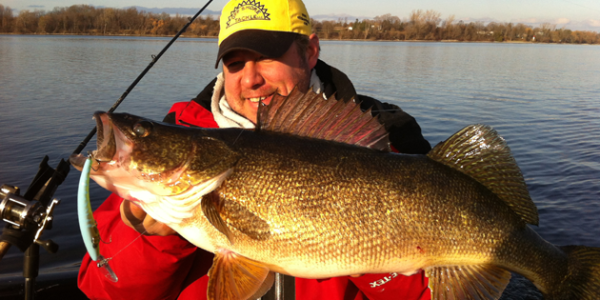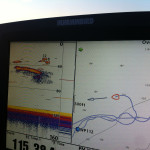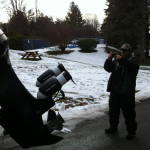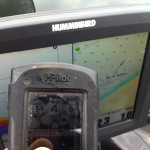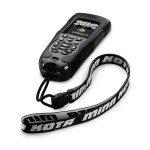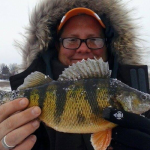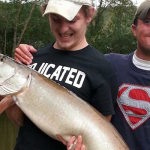By JP Bushey
Jutting eastward from the inland sea that is Lake Ontario, The Bay Of Quinte is on our planet’s short list of fisheries for walleye over ten pounds. Insulated from the big lake and her mood swings, The Bay really is a world unto itself. Walleye fishermen use a battery of methods, in all seasons, targeting both resident and migratory populations. I’d argue that the best window for enormous walleye is just before freeze-up, as staggering numbers of huge, open-water fish funnel their way inland, tugged along by urges to gorge-feed, to winter over and to spawn the following spring.
Given the weather conditions, the amount of water available and the transient nature of these walleye, trolling techniques are a natural fit. Patterns emerge. And when they do, results can verge on the unbelievable. Very few fishing opportunities draw me down snowy, salty highways for over three hours with boat in tow, eager to bang around in icy water for days on end. But this one does. I’ve busted out trailer lights in iced up ramps, dried my soaked laundry at day’s end in local laundry mats wearing a parka over my long underwear and slept in my truck along the shoreline more times than you’d believe. The Bay of Quinte is that special. Anyone who’s fished it for any length of time has the stories. Double headers of fish over thirteen pounds? Absolutely. Watching a boat partner’s personal best get doubled on a single trolling pass? That’s regular. Having that same mark re-shattered multiple times in a weekend? For sure. There’s just nowhere else on earth like it.
Attention to detail, and the ever-delicate balance between riding confidence and breaking new ground is what drives the Quinte trolling program. Fishing this time of year is a beautiful battle, and certainly one that carves itself into you, for life.
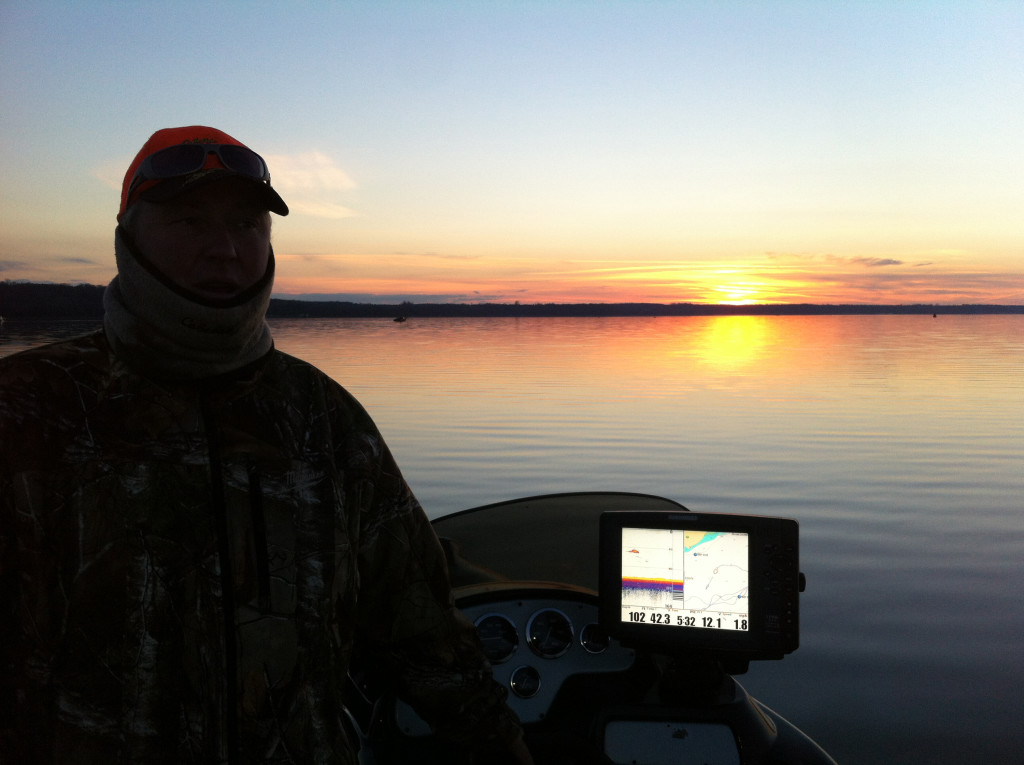
Standard-Issue Rigging
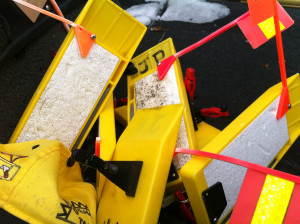 The bulk of successful trolling is done behind inline planer boards, snap weights and leadcore line, in a bunch of differing combinations. Off Shore Tackle’s OR12 inline board is the most popular and I couldn’t even guess which brand or model comes in second. OR12s are a stable, visible board, and can be outfitted with a range of attachment clips to handle a variety of fishing lines and wave conditions. Quinte’s pre-freeze legend was born on this board’s back. Braided and fused ‘superlines’ have their fans, as does monofilament. All superlines will gather excess water and in freezing temperatures, this can be a problem for rod guides and reels jamming with ice. Monofilaments shed water, tend to run more trouble-free and also offer heavy fish plenty of cushion for staying hooked. Mono reacts slower, because of its natural stretch. By the time you see a board move, that fish has already grabbed your bait fully. I troll with ten pound monofilament almost exclusively. Landing percentages are close perfect. Plus, I’ve patterned all of my lure depths based on its diameter. Some walleye aggressively ‘t-bone’ lures and are hooked solidly. Others sometimes barely nip that tail hook. Forgiving, stretchy monofilaments really stacks the odds in your favour when trolling in cold water, at low speeds. On leadcore outfits, extended fluorocarbon leaders of thirty feet or more give you the same benefits.
The bulk of successful trolling is done behind inline planer boards, snap weights and leadcore line, in a bunch of differing combinations. Off Shore Tackle’s OR12 inline board is the most popular and I couldn’t even guess which brand or model comes in second. OR12s are a stable, visible board, and can be outfitted with a range of attachment clips to handle a variety of fishing lines and wave conditions. Quinte’s pre-freeze legend was born on this board’s back. Braided and fused ‘superlines’ have their fans, as does monofilament. All superlines will gather excess water and in freezing temperatures, this can be a problem for rod guides and reels jamming with ice. Monofilaments shed water, tend to run more trouble-free and also offer heavy fish plenty of cushion for staying hooked. Mono reacts slower, because of its natural stretch. By the time you see a board move, that fish has already grabbed your bait fully. I troll with ten pound monofilament almost exclusively. Landing percentages are close perfect. Plus, I’ve patterned all of my lure depths based on its diameter. Some walleye aggressively ‘t-bone’ lures and are hooked solidly. Others sometimes barely nip that tail hook. Forgiving, stretchy monofilaments really stacks the odds in your favour when trolling in cold water, at low speeds. On leadcore outfits, extended fluorocarbon leaders of thirty feet or more give you the same benefits.
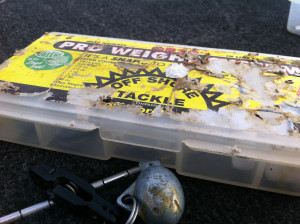 Snap-weights, like Off Shore’s Guppy and Tadpole, completely changed my life when I started trolling them. For one, I was now able to send any lure in the box down to any level I wanted. It could be a little wee, three inch, shallow-diving minnowbait or a paper-thin flutter spoon. You can clip one ahead of a large-lipped crankbait and send it down on an even steeper angle. For me, snap-weights shine whenever I want to reach hot depths with minimal line out behind my board or behind the boat. And to be clear, there are times almost every trip when a plain Jane flatline straight off the gunnel or transom with a Guppy Weight absolutely dominates. I have no explanation for it. We always call that rod the ‘Junk Line.’ It sits in a rod holder–lure in idiotic lockstep with the boat’s path–and gets trampled, while boards carry their goods out into exotic, virgin patches of water and turn up zeros. On a whim many years ago, I clipped a fat, 3oz Guppy twenty feet ahead of an Eriedescent Reef Runner Ripstick and plunked it back only seventy five feet. The other lines were pretty much a waste of time that day! Not only did that set-up fire consistently for three solid days, it also scooped every single one of our walleye over ten pounds. By trip’s end, it wasn’t even a fair fight. The Junk Line really wailed them.
Snap-weights, like Off Shore’s Guppy and Tadpole, completely changed my life when I started trolling them. For one, I was now able to send any lure in the box down to any level I wanted. It could be a little wee, three inch, shallow-diving minnowbait or a paper-thin flutter spoon. You can clip one ahead of a large-lipped crankbait and send it down on an even steeper angle. For me, snap-weights shine whenever I want to reach hot depths with minimal line out behind my board or behind the boat. And to be clear, there are times almost every trip when a plain Jane flatline straight off the gunnel or transom with a Guppy Weight absolutely dominates. I have no explanation for it. We always call that rod the ‘Junk Line.’ It sits in a rod holder–lure in idiotic lockstep with the boat’s path–and gets trampled, while boards carry their goods out into exotic, virgin patches of water and turn up zeros. On a whim many years ago, I clipped a fat, 3oz Guppy twenty feet ahead of an Eriedescent Reef Runner Ripstick and plunked it back only seventy five feet. The other lines were pretty much a waste of time that day! Not only did that set-up fire consistently for three solid days, it also scooped every single one of our walleye over ten pounds. By trip’s end, it wasn’t even a fair fight. The Junk Line really wailed them.
It’s worth noting that in the rough, rolling seas that typify the late game on Quinte, snap-weights really shine. Running baits closer to the boat is always easier to get away with when the water’s surface is being chopped up in surf. Rigs that follow the boat will generate. Maybe more critically, is the all the extra action your bats get from all this. In big seas, with the boat surging and stalling through the waves, all that motion gets transferred straight down to your lures. ‘Slingshotting’ is how I describe it. A heavier snap-weight, shorter lead between boat and lure and some wave action can be a fabulous trigger for walleyes. And don’t forget, in water that’s regularly well below 40 degrees F and plastered with shad and other food, little stuff like this makes a big difference on walleye that are old, educated, well-fed and operating in a lower gear, metabolically. What I like about snap-weights is how my set-up can be adjusted. Simply squeeze the release pad and relocate it up or down your mainline. Want to add or drop weight? No problem, slide them on or off the big, easy splitring. The whole program is designed for versatility, and this is a huge reason why so many trollers use it.
Leadcore remains a Great Lakes favorite, and certainly has a place in the Quinte playbook. Its Dacron coating can be messy in cold weather, holding lots of water, as any braided line will. But when you’re able to fish it, leadcore sneakily delivers lures down to schools of walleye. You’re able to plumb those sonar marks down twenty five feet or more with no diving planer, cannonball or inline weights. Leadcore is stealthy. Eighteen to twenty pound is ideal. Five colour set-ups are typically more than enough. Subtle, delicate baits like Reef Runner Ripsticks, Floating no11 Rapalas or spoons can be presented accurately and naturally, at some impressive depths.
Two to three colours pulls well behind inline trolling boards, too. Splice them into twelve to fifteen pound mono, and set them out. Spoons are a deadly lure option. They don’t work as consistently as plugs, but when big walleye are taking spoons, that’s all they’ll hit. Always carry some. Thin models that work at low speeds are what you want. The stuff you’d cast for pike aren’t it. Williams Wabler Lites, Savant Jakes and the old Mooselook Wobbler are all great, dragged under 2mph. Spoons are a really great bait to run on the Junk Line in rough weather, believe me. Baits like Williams have jewelry-quality silver and gold finishes. Flash is a huge part of what makes a spoon so good, and they’re not all created equally.
Like you’d expect, Quinte draws a lot of traffic, and pods of walleye do see plenty of baits. Being sneaky has always worked well for me, down there. What leadcore lacks in efficiency, with it’s long leads and more cumbersome rigging, it definitely makes up for in stealth. Of course, the ultimate is feeding out three to four colours of lead spliced into your mainline, behind a trolling board. Like a good pitcher, the offering travels down and away. Your baits wind up in great locations where walleye can suck them back in peace. Not all boards can handle leadcore’s drag and weight through the water. The Off Shore OR12 can.
Cold weather trolling for big fish is hard on all your gear. Any little defect get exposed fast, that’s for sure. And damage control with bare, wet hands in a boat in December isn’t something you’ll enjoy, take my word on that one. Across the board, use the best-quality rods, reels and rigging you can. I use linecounter reels from Daiwa and Shimano, and spool with premium Maxima monofilaments and fluorocarbons. Counters, drags, levelwinds, knots, leaders and hooks are all checked and re-checked prior to heading out. Every fishing-related task is tougher in cold weather, from trailering to launching, even changing baits or netting fish. Set yourself up for maximum production in cold weather. Make every strike count.
Rank Those Cranks
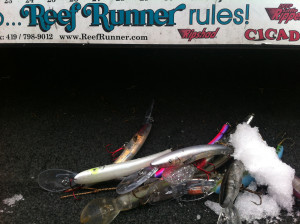 Like with so many other Great Lakes scenes, Quinte walleye lock onto really specific colours. I’ve spent my entire life on Georgian Bay, a massive elbow off Lake Huron, and it’s much the same there. If you’ve got the wrong colour for that day, you may as well troll with a crushed up pop can. I’ve never seen a fishery that’s more colour-dependant than Quinte. Lure shape, lure action and lure depth are all huge, and you have to dial all that in first, there’s no way around those three. After that, we really watch for hot colours to emerge. Expect to ride a hot colour while it’s firing. It’s absolutely unreal how prominent this element of your presentation is down there.
Like with so many other Great Lakes scenes, Quinte walleye lock onto really specific colours. I’ve spent my entire life on Georgian Bay, a massive elbow off Lake Huron, and it’s much the same there. If you’ve got the wrong colour for that day, you may as well troll with a crushed up pop can. I’ve never seen a fishery that’s more colour-dependant than Quinte. Lure shape, lure action and lure depth are all huge, and you have to dial all that in first, there’s no way around those three. After that, we really watch for hot colours to emerge. Expect to ride a hot colour while it’s firing. It’s absolutely unreal how prominent this element of your presentation is down there.
Quinte has cleared a lot in the time I’ve been fishing it, close to twenty years. But in no way has clearer water automatically meant you need clear water colours. Not even close. These days, whacko patterns like purple/pink, blue/chartreuse, Clown and Firetiger are as hot as ever. Great Lakes browns, steelhead and chinook usually play the same way as the walleye do. Colour is key, and some borderline ridiculous patterns regularly blow the rest of it away. If I had to bet my truck and boat on a ten pounder tomorrow, I’d take a Reef Runner Deep Runner, in Purple Demon pattern. That lure looks flat-out horrible. I carry no fewer than six in the boat at all times, two of which are always in the water. One real high, running less than twelve feet down, the other set at about eighteen. You let me run that for a day and I bet you I keep my stuff.
Like so many other guys, Reef Runners are my go-to crankbait at giant time. There’s three reasons for that. Number one, They’re a Great Lakes company. To this day, every single Reef Runner you buy is American Made, and their colour chart revolves around all the things we’ve already looked at, with respect to selective, Great Lakes predators and how they prefer specific lure colours. Reef Runner paints it all, from dreamy naturals to toxic nightmares. And you’ll want to carry a range of it, trust me. Second, every Reef Runner comes with premium, Kahle-style Eagle Claw treble hooks. Any big walleye that nips or bats at your bait will get tagged. I do a lot of muskie and pike fishing and can tell you without hesitation that 99% of the lures on the market come with hooks that are the wrong size and/or of inferior quality. Honestly, is there anything worse than paying for a lure that needs new hooks on it, before you even use it? Open a Reef Runner, put it in the water and fish it confidently. There’s very few crankbaits in production right now that can lay that claim. A reef Runner is ready-to-fish the second you pick it up. Same old story here: a quality, affordable bait that fishermen in our neck of the woods create and build. Call it what you will, but I’ll never shy away lures built and designed from places close to where we use them.
Lastly, and maybe most importantly, these lures have what I call ‘The Shiver.’ I’ve spent a lot of hours watching my trolled lures on Quinte with a Go Pro or AquaVu. There’s no doubt in my mind that at the speeds December walleye like—from 0.2 to about 0.7mph—no other lure has that same tight, subdued wobble. Mann’s Stretch 25s have it to a degree, and so do a couple of the Live Target Smelts. But year in and year out, over the tight range of speeds these fish like, nothing is as consistent as a Reef Runner. And that goes for both the Deep Runners as well as the Ripsticks. Ripsticks run with a little more wobble and max out around ten feet, with their stubby lip. They’re ideal for Guppy Weight or leadcore duty. A consistently deadly lure that doesn’t cost as much as replacing a set of busted trailer lights and also happens to be domestically produced? Lots of trollers appreciate this.
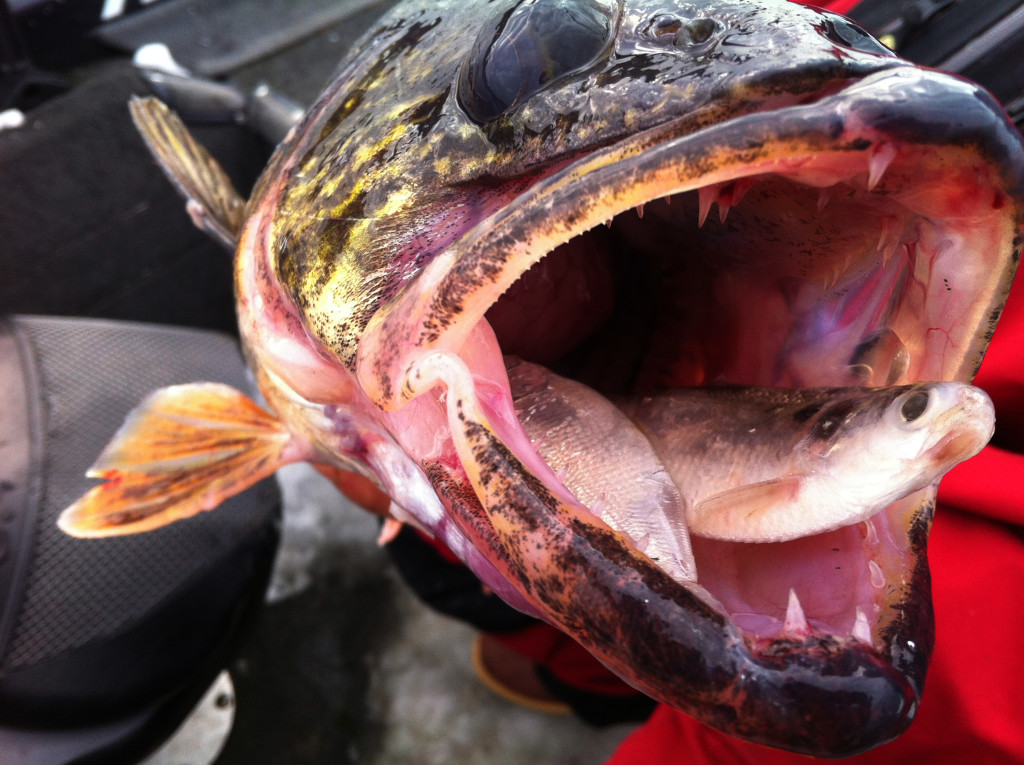
Winning The Wind & Boat Control War
Even though Quinte sits well inland from Lake Ontario, a lot of the fishing takes place in long, narrow reaches, channels and bays. Long Reach, Adolphus Gap, Glenora Reach and Picton Bay all put you directly in the trolley tracks. Winds have plenty of room to power through these areas and blow up large rollers. They’re the places walleye are naturally migrating through, and the fishing can be fantastic. Learning how to manage wind is just another part of the overall program. Walleye and a little wind go together just about anywhere and nearly anytime. Safe running and trolling both need to be respected. I pass on spots every trip. There’s always fish to be caught without putting yourself and your gear at risk.
Trolling downwind is just about anybody’s first choice. Bait speed can be dialed right in, and so can the direction of your boat. My entire career on Quinte has been spent fishing out of Picton Bay, at Merland Park Cottages. I’ve been lucky enough to spend a lot of hours with the camp’s owner, Kevin Lavers, trolling. To this day, I’ve never seen somebody on Quinte use electronics as optimally as Kev does. Not only GPS mapping/trolling motor linking systems like iPilot, but electric motor trolling in general. In calm seas, we’ll shut the kicker right down and troll with the bow mount. Slipping silently along is sneaky and we run it off the iPilot Remote, from anywhere in the boat. When the winds kick up, we still run under electric power, using a Minn Kota Riptide Mount. It’s a fully electric, double-propped unit that mounts to the cavitation plate on your outboard. Like iPilot, it’s hand-controlled and can be micromanaged to suit any speed the walleye want. And this unit packs a punch. At the push of a button you can go from creep-crawling along to a reverse thrust to net a fish.
Kevin and I had an unbelievable afternoon session last December, board trolling on the Lake Ontario side of the famous Glenora Reach. With The Kevin’s docks in the bottom reaches of Picton Bay ice-locked, we hopped the Glenora Ferry to reach open water. This is a really typical occurrence on Quinte this time of year. Where else on earth would a guy shovel a foot of snow out of his driveway and then trailer down the road to load his rig onto another boat in order to find an ice-free launch? It’s surreal, fun and all part of the experience.
The first walleye that dipped an inside board back weighed less than eight pounds, which is small for the area. But beside the boat, she hacked out a fresh shad about four inches long. Kev dialed the Riptide back to less than 1mph and we spent the next four hours trolling through a pod of walleye hanging out in an area the size of a hockey rink. We took that shad and chopped it up with a filet knife, rubbing the mush all over our baits, for scent. Kev had been hammering fish for two solid days guiding using a Reef Runner Deep Diver in Kool Kiwi pattern. If you’ve never seen Kool Kiwi, brace yourself. It looks like someone mixed grass clippings with Aqua Fresh toothpaste and then shot it all over the lure with an airbrush. Remember that bit about Quinte and lure colour? That day was a classic example. We finished off right at dark with back-to-back heavy, strong sows about twelve pounds each. Eight to ten pound walleye had been jumping on Kool Kiwi every time we reloaded and got it set back out in the trolling spread. Spoiled for life on giant walleye? The Bay of Quinte will do that to you. I’ve been lucky enough to live it.
Golden Close
Believe me when I tell you that The Bay of Quinte is as advertised. And there are some unreal guide outfits down that way. Look up any of the following if you’re into a trip: Merland Park Cottages, Taro Murata’s Fish City Tours, Nicholas Werner’s Angling Adventures, Joe Pickstock at PB & J Charters, Cabela’s Canada Pro Staff Jeff Chisholm, plus many more. All these guys are on Facebook and have good websites. The reality is that the big walleye are forced through the areas you’ll be trolling. Fish locations are pretty standard. Year after year, the biggest play you can make is trolling smart by dialing in your presentation variables and basically forcing the fish you’re driving over to bite. If all else fails, you can always call me at (705) 717-3159 or message me on Facebook at The Bushey Angle. The pre-freeze bite for walleye is one I’ve been lucky enough to enjoy for many years and I’ll happily tell you what I know about it.
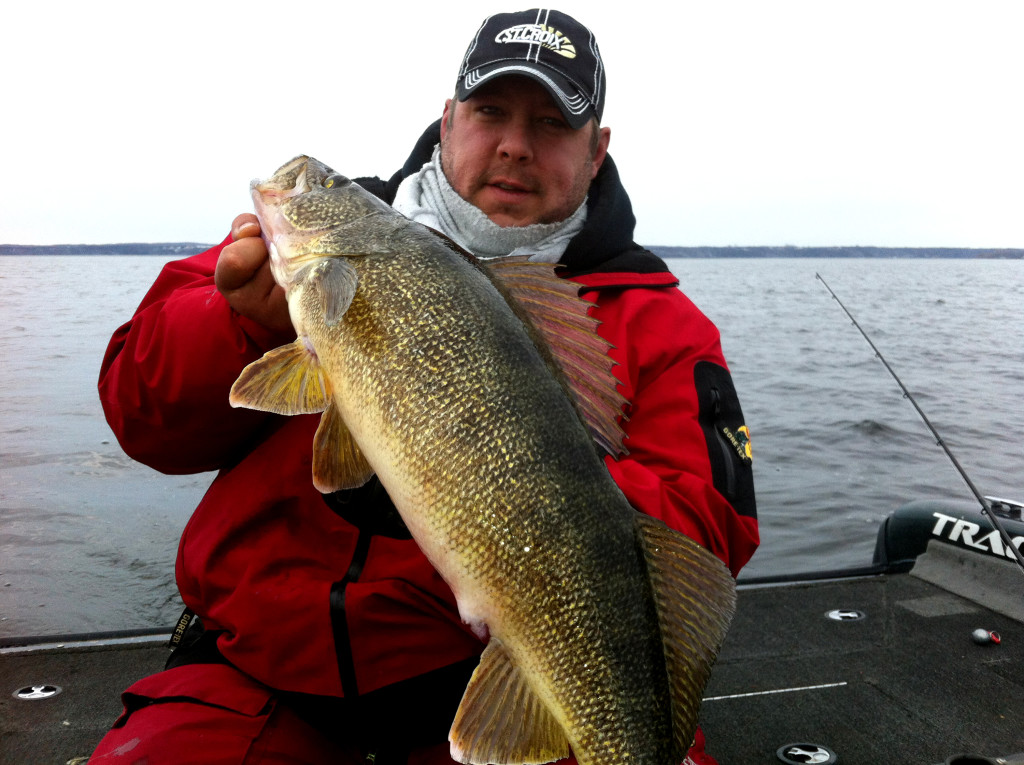
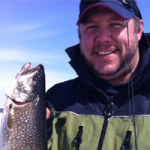 JP Bushey
JP Bushey
JP Bushey is a multi-season, multi-species writer from Barrie, Ontario. Northcentral Ontario’s ‘big water’ is where he spends his time, including Georgian Bay, Lake Nipissing, The French River and The Bay of Quinte. He does speaking engagements, manufactures lures and takes pride in helping people improve their fishing success. You can follow his fishing adventures on Facebook at The Bushey Angle, and on the web at www.thebusheyangle.com


